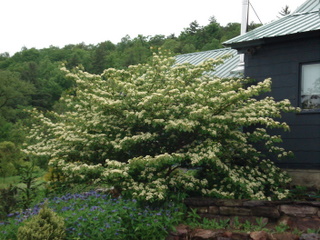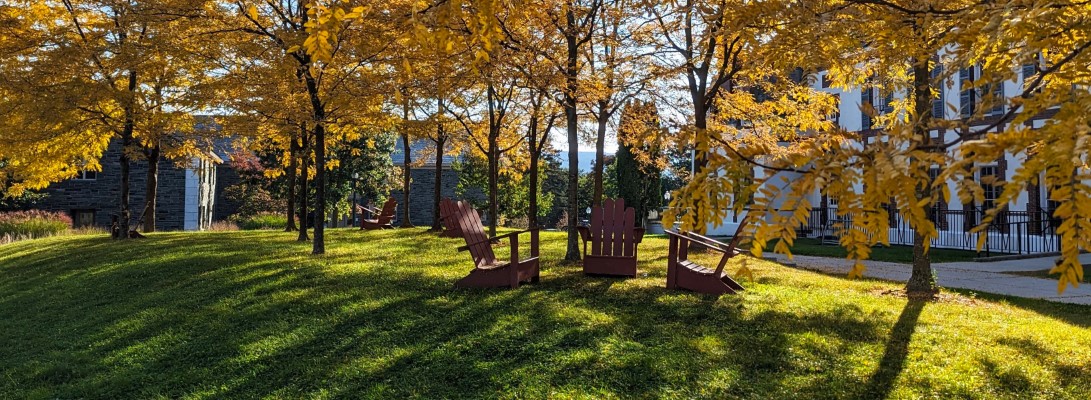There is another, better Dogwood in bloom right now on campus, a native. Pagoda Dogwood, Cornus alternifolia. 
Let’s start by saying the previous owners of our house were not outside people: there was a mown path to the dog kennel, and another to the clothesline. But really, would I have liked any existing landscaping anyway? The south side of our house was a thicket of Box Elder, Honeysuckle, and the wild Multiflora rose, in a row about 15’ wide by 25’ long, Not being one to let a sunny spot go to waste, I start cutting with a chainsaw, literally on my hands and knees in the thicket, when I see something unusual, so I stop.
It was a Pagoda Dogwood, not 2’ from where I was actually planning to plant one. I clear cut everything else, leaving the tree for the mice to eat the bark off of the trunk that winter. Just my luck, I thought, until I watch it sucker up from the roots, grow about 5’, and I prune it to a lovely 3 stem clump.
A beautiful little tree, this native species is often seen as an understory tree in our Vermont woods, usually along the edges. Planted out in the landscape, however, is where the tree really starts to shine. Pagoda Dogwood is about the size of a large crabapple, 15-25’ tall, and at least that in width, if not by half again. Like the over-planted cousin down south, the Flowering Dogwood, look for its architectural shape, with very horizontal branching arrayed in tiers up the trunk. I use it for this effect alone sometimes, planting them in yards near the woods, where the homeowners are looking at a forest of vertical tree trunks, letting the horizontal branching of the Pagoda give some relief to the eye.
The leaves are a medium to dark green, alternating along the stem, hence the latin name. They stay clean and attractive all summer long. White flowers appear along the stem right around now (last week of May) and are effective for a couple of weeks before turning brownish. The UConn website states the flowers are only “moderately showy”, but, if you ask me, they are spoiled by Japanese Maples and other zone 5-6 plants. We Vermonters take spring whenever we can get it. Michael Dirr describes the fragrance as sickly sweet, but I don’t find it obnoxious or particularly strong for that matter. A pretty bluish purplish black fruit hangs in clumps in the fall, which makes up for an underwhelming but still pretty yellow to reddish purple fall leaf color. Good for wildlife, the berries are quickly eaten by the birds. The bark is a smooth reddish brown on younger wood, turning an attractive grayish brown as it ages. Even with no leaves, its habit lends a certain grace to the landscape, and is much more interesting than may evergreens I won’t name (trimmed yews, cough, cough).
Many sources claim the tree does best in part shade, although full sun is fine as long as the location is not too hot or day. Mine is on the southeast corner, bakes all day in one of the drier locations of our yard, and I have no complaints, although I will confess to the occasional patio water fight with the kids next to it (they win). Picture it in its natural habitat in the forest, and you can imagine the ideal plating location. A flowering tree that can handle part shade is a good plant to have in your bag of tricks. Stem canker and some fungal leaf spotting can sometimes be a bother. It is resistant to dogwood anthracnose, the scourge of Flowering Dogwood.

I just read your reply to my earlier email, Tim., and then through your very enjoyable blogs. I learned a lot…and will continue to tune in.
Best,
Marilyn DeL.